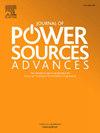Analysis of carbon-binder domain morphology and correlation to effective ion transport properties
IF 4.6
Q2 CHEMISTRY, PHYSICAL
引用次数: 0
Abstract
The conductive additive and binder domain (CBD) is an essential component of lithium-ion battery electrodes. It enhances the electrical connectivity and mechanical stability within the solid electrode matrix. The CBD aggregate exhibits inner porosity that significantly impacts ion transport within the electrode. Thus, the spatial distribution of CBD and its morphology play a critical role for ion transport pathways within the electrode. In order to quantify the extent of this influence, we employ high-resolution focused ion beam/scanning electron microscopy (FIB-SEM) imaging and isolate regions with just solid CBD and pore. This enables us to quantitatively correlate the CBD morphology with physical transport parameters and present a function that describes the relationship between CBD porosity and its ionic conductivity. Through our work, we provide insights into the CBD microstructure for use in future continuum-scale models.
碳结合剂结构域形态分析及其与有效离子传输特性的关系
导电添加剂和粘结剂域(CBD)是锂离子电池电极的重要组成部分。它增强了固体电极基体内的电连通性和机械稳定性。CBD聚集体表现出内部孔隙,显著影响离子在电极内的传输。因此,CBD的空间分布及其形态对电极内离子传输途径起着至关重要的作用。为了量化这种影响的程度,我们采用高分辨率聚焦离子束/扫描电子显微镜(FIB-SEM)成像并分离只有固体CBD和孔隙的区域。这使我们能够定量地将CBD的形态与物理运输参数联系起来,并提出一个描述CBD孔隙率与其离子电导率之间关系的函数。通过我们的工作,我们提供了对CBD微观结构的见解,用于未来的连续尺度模型。
本文章由计算机程序翻译,如有差异,请以英文原文为准。
求助全文
约1分钟内获得全文
求助全文

 求助内容:
求助内容: 应助结果提醒方式:
应助结果提醒方式:


